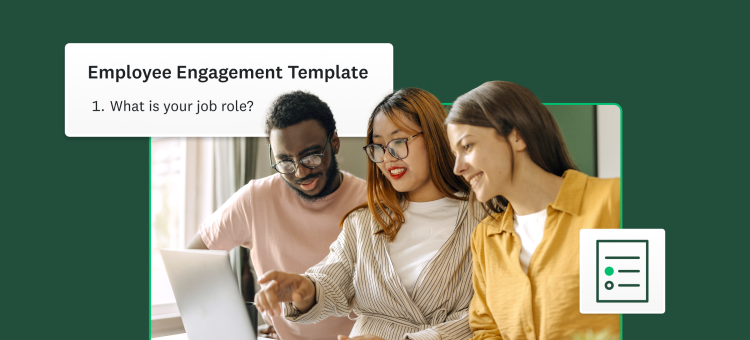For HR pros, executive buy-in isn't optional—it's essential for building workplace benefits and wellness programs that employees need and love. HR leaders "have a vast presence over the entire organization," says Antoine Andrews, chief diversity and social impact officer at SurveyMonkey. "Being able to set the tone with their executive teams is very important, and it allows it to reverberate throughout the entire organization."
During the recent SurveyMonkey Employee Experience Summit, Andrews joined other SurveyMonkey HR leaders, including Chief People Officer Becky Cantieri and Senior Manager, Learning & Development Kaylee Cartwright to discuss how to build effective benefits and wellness programs.
Their key message: success requires both executive support and a robust employee feedback loop—asking the right questions, listening to responses, and taking meaningful action. This article explores how organizations can implement this process, from securing executive buy-in to maintaining beloved benefits for diverse needs.
To watch all of the Employee Experience Summit sessions, click here.
Making the data-driven case for executive support
Sometimes it takes hard data to make the business case for benefits that align with employee needs. "There's tons of research out there," Cantieri notes, "including research from Gallup that shows the connection between employee well-being and productivity or business outcomes, whether it's in the form of fewer sick days or higher overall performance."
This connection between well-being and business outcomes is a compelling argument for investing in robust benefits packages. However, currently there’s a perception gap that needs addressing. According to our latest research, while 86% of HR professionals believe leadership understands employee needs, only 63% of employees agree (to learn more about this study, watch the session).
Bridging the HR gap through a secure, comprehensive platform
To bridge the disconnect between HR perceptions and employee reality, organizations need a secure, sophisticated approach to gathering and analyzing feedback. SurveyMonkey provides this through a comprehensive suite of tools designed to both protect employee privacy and deliver actionable insights.
At its foundation, the SurveyMonkey platform's advanced collaboration and security controls ensure response anonymity, creating an environment where employees feel safe providing candid feedback. SurveyMonkey benchmarkable templates can then be used to understand how satisfaction rates for their benefits programs compare to industry standards.
Through sentiment analysis and crosstab reports, HR leaders can quickly surface actionable insights about employee preferences and needs. Customizable dashboards transform raw data into clear visualizations that help leadership pinpoint exactly which actions will drive engagement. The platform's segmentation tools allow teams to analyze feedback across demographics, departments, and other key variables, ensuring no employee group's needs are overlooked.
Creating wellness programs that drive results
Cantieri emphasizes the importance of using data strategically: "Your own internal data can really bring employee needs home and make it personal for your organization." This context is important and, as Andrews points out, constantly evolving. "Employees' needs change over time, whether they're in a different career, they've been promoted, or if they're at different stages in their lives."
Meeting these evolving needs requires a dynamic approach to benefits design. Start by ensuring your feedback mechanisms are accessible to all employees, offering surveys in multiple languages and segmenting data across various demographics. This enables you to design truly inclusive benefits packages that serve the entire workforce, not just the majority.
The impact of these programs should be continuously monitored through key performance indicators (KPIs), combining traditional metrics like employee engagement scores and retention rates with broader measures of organizational health.
To maintain program effectiveness, organizations should regularly reassess offerings against changing employee needs, and monitor competitive benchmarks within their industry.
The employee feedback loop: Ask, listen, act
To bring all of the panel discussion insights together, Cantieri presented an "Ask, Listen, Act" framework. Deceptively simple, this strategic approach will help you build benefits programs that truly resonate with employees while meeting business objectives. "The key is creating a continuous dialogue," Cantieri explains. "Each phase informs the next, creating a dynamic process that evolves with your workforce's needs."
Here's how organizations can implement each phase effectively:
Ask strategically
Rather than deploying generic surveys, organizations need to be intentional about how they gather feedback.
- Start with pre-written HR survey templates designed by HR experts, or create custom questionnaires tailored to your organization's unique culture and needs
- Gather comprehensive feedback on current benefits through regular pulse surveys and focused deep-dives during key periods like open enrollment
- Use advanced question types (like MaxDiff) to explore employees' desired benefits, allowing them to rank preferences and make trade-off decisions
Listen intentionally
Using all of that data together to tell the story of your employee experience requires a methodical approach to analysis.
- Use sentiment analysis tools to understand not just what benefits employees value, but why they value them
- Conduct gap analysis between current offerings and employee needs, identifying both immediate opportunities and long-term strategic improvements
- Use demographic segmentation to understand how benefits preferences vary across different employee groups, ensuring equity in your offerings
Act decisively
The final phase is perhaps the most critical. As Cantieri emphasizes, "Even if the decision to act is not what they're directly asking for, you need to close the loop with employees and make sure they know their voice was heard."
- Create clear action plans based on survey findings, prioritizing changes that offer the highest impact for both employees and the organization
- Communicate decisions transparently, explaining not just what changes are being made, but why they were chosen
- Implement changes systematically, with clear timelines and ownership
Remember, creating effective benefits programs isn't just about offering the right perks—it's about building strategic initiatives that drive business success through enhanced employee well-being. With proper executive support and data-driven decision-making, you can create programs that really make a difference in people’s lives.
Ready to enhance your benefits program? Start gathering employee feedback to build a data-driven case for executive support.



